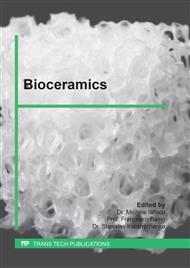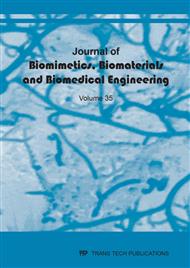[1]
M. G. Gandolfi, G. Ciapetti, P. Taddei, F. Perut, A. Tinti, M. V. Cardoso, B. V. Meerbeek, C. Prati, Apatite formation on bioactive calcium-silicate cements for dentistry affects surface topography and human marrow stromal cells proliferation, dental materials 26 (2010).
DOI: 10.1016/j.dental.2010.06.002
Google Scholar
[2]
M. G. Gandolfi, G. Ciapetti, F. Perut, P. Taddei, E. Modena, P. L. Rossi, C. Prati, Biomimetic calcium-silicate cements aged in simulated body solutions. Osteoblast response and analyses of apatite coating, Journal of Applied Biomaterials & Biomechanics 7 (2009).
Google Scholar
[3]
P. Taddei, E. Modena , A. Tinti, F. Siboni, C. Prati, M. G. Gandolfi, Vibrational investigation of calcium-silicate cements for endodontics in simulated body fluids, Journal of Molecular Structure 993 (2011) 367–375.
DOI: 10.1016/j.molstruc.2010.12.058
Google Scholar
[4]
Q. Lin, W. Zhang, C. Lu, G. Hou, Z. Xu, In vivo investigation of biological responses to tricalcium silicate pastes in muscle tissue, Ceramics International 40 (2014) 1879–1883.
DOI: 10.1016/j.ceramint.2013.07.092
Google Scholar
[5]
M.M. Radwan, H.K. Abd El-Hamid, A.F. Mohamed, Influence of saline solution on hydration behavior of ß-dicalcium silicate in comparison with biphasic calcium phosphate/hydroxyapatite bio-ceramics, Materials Science and Engineering C 57 (2015).
DOI: 10.1016/j.msec.2015.07.011
Google Scholar
[6]
Nuan La-ong Srakaewa and Sirirat Tubsungnoen Rattanachan, The pH-dependent Properties of the Biphasic Calcium Phosphate for Bone Cements, Journal of Biomimetics, Biomaterials and Biomedical Engineering Vol. 21 (2014) pp.3-16.
DOI: 10.4028/www.scientific.net/jbbbe.21.3
Google Scholar
[7]
C. TzeKao T.H. Huang Y.J. Chen, C.J. Hung, C. C. Lin, M.Y. Shie, Using calcium silicate to regulate the physicochemical and biological properties when using ß-tricalcium phosphate as bone cement, Materials Science and Engineering C 43 (2014).
DOI: 10.1016/j.msec.2014.06.030
Google Scholar
[8]
W. Qianqian, L. Feng, S. Xiaodong, S. Wujun, L. Xuerun, G. Yanhua, X. Shijie, Z. Qing, Relation between reactivity and electronic structure for α, α'H, α'L, β and γ-dicalcium silicate: A first-principles study, Cement and Concrete Research 57 (2014).
Google Scholar
[9]
J. E. M.S. de Val, J. L. C. Guirado, J.M. G. Marín, G. G. Moreno, P. Mazón, P. N de Aza, Material characterization and in vivo behavior of dicalcium silicate cement modified with phosphorus, Ceramics International 42 (2016) 952–960.
DOI: 10.1016/j.ceramint.2015.09.024
Google Scholar
[10]
D.K. Smith, A. Majumdar, F. Ordway, The crystal structure of ɣ-dicalcium silicate, ActaCrystallogr. 18 (1965) 787 –795.
DOI: 10.1107/s0365110x65001780
Google Scholar
[11]
W. Eysel, T. Hahn, Polymorphism and solid solution of Ca2GeO4 and Ca2SiO4 , Z. Kristallogr, Bd. 31 (1970) 322 – 341.
Google Scholar
[12]
My.Y. Benarchid, A. Diouri, A. Boukhari, J. Aride, I. Elkhadiri, Hydration of iron–phosphorus doped dicalcium silicate phase, Materials Chemistry and Physics 94 (2005) 190–194.
DOI: 10.1016/j.matchemphys.2005.04.047
Google Scholar
[13]
M. A. H. Duarte, G. D. O. El Kadre, R. R. Vivan, J. M. G. Tanomaru, M. T. Filho and I. G. de Moraes, Radiopacity of Portland Cement Associated With Different Radiopacifying Agents, Journal of Endodontics Volume 35 (2009).
DOI: 10.1016/j.joen.2009.02.006
Google Scholar
[14]
T.Y. Chiang and S.J. Ding, Comparative Physicochemical and Biocompatible Properties of Radiopaque Dicalcium Silicate Cement and Mineral Trioxide Aggregate Journal of Endodontic, 36 (2010).
DOI: 10.1016/j.joen.2010.07.003
Google Scholar
[15]
A. Bouregba and A. Diouri, Potential formation of hydroxyapatite in total blood and dicalcium silicate elaborated from shell and glass powders, Materials Letters 183 (2016) 405–407.
DOI: 10.1016/j.matlet.2016.07.153
Google Scholar
[16]
A. DIOURI; A. BOÜKHARI; J. ARBDE; F. PUERTAS et T. VÁZQUEZ, Formation d'hydroxyapatite, Ca5(PO)3OH, en milieu silicate, MATERIALES DE CONSTRUCCIÓN, 44(1994) 236.
Google Scholar
[17]
A. M. Deliormanli, Investigation of in vitro mineralization of silicate-based 45S5 and 13-93 bioactive glasses in artificial saliva for dental applications, Ceramics International 43 (2017) 3531–3539.
DOI: 10.1016/j.ceramint.2016.11.078
Google Scholar
[18]
F. Puertas and F. Triviňo, Examinations by Infra-Red Spectroscopy for the polymorphs of dicalcium Silicate. Cement and Concrete Reserch. 15 (1985) 127-133.
DOI: 10.1016/0008-8846(85)90017-1
Google Scholar
[19]
I.M. Martínez, L. Meseguer-Olmo, A. Bernabeu-Esclapez, P.A. Velásquez, P.N. De Aza, In vitro behavior of α-tricalcium phosphate doped with dicalcium silicate in the system Ca2SiO4–Ca3(PO4)2, materials characterization 63 (2012 ) 47 – 55.
DOI: 10.1016/j.matchar.2011.10.013
Google Scholar
[20]
F.R. Tay, A review of the bioactivity of hydraulic calcium silicate cements, journal of dentistry 42 (2015) 517-533.
Google Scholar
[21]
M. R Majhi, R. Kumar, S. P Singh and R. Pyare, Physico-chemical Properties and Characterization of CaO-Fe2 O3-P2O5 glass as a Bioactive Ceramic Material, Journal of Biomimetics, Biomaterials and Tissue Engineering Vol. 12 (2011) pp.1-24.
DOI: 10.4028/www.scientific.net/jbbte.12.1
Google Scholar
[22]
Larry L. Hench, Bioceramics, J. Am. Ceram. Soc., 81(1998)1705–28.
Google Scholar



